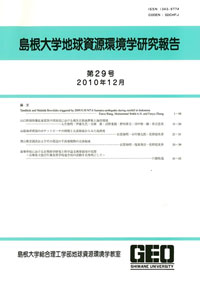島根大学総合理工学部地球資源環境学教室
ISSN:1343-9774

ダウンロード数 : ? 件
この文献の参照には次のURLをご利用ください : https://ir.lib.shimane-u.ac.jp/6396
島根大学地球資源環境学研究報告 17
1998-12-25 発行
Geochcmical indication of contrasting Holocene sediments related to sea-level change in coastal lagoon of the San'in disthct, Southwest Japan
Geochemical indicatlon of contrasting Holocene sediments related to sea-level change in coastal lagoon of the San'in dist-ct, Southwest Japan
ファイル
内容記述(抄録等)
Geochemical analysis of Holocene sediments related to the sea-level change has been carried out for evaluation of changes in sedimentary environment.The Jomon transgression(from 10 k yrs BP)resulted in accumulation of organic black muds of the Shinjiko Formation,while succeeding regression in the Yayoi age(from 2400 yrs BP)led to deposition of the Asakumi Formation under backswamp condition of the nuvial system from the Kofun(4-6 C)to Heian(9-10 C)ages.
Changes in sedimentary environments are clearly demonstrated by geochemical indicators,such as TOC/TS and TOC/TN,SiO_2/Al_2O_3,Al_2O_3/TiO_2,and Ti/Zr ratios.Variation of SiO_2/Al_2O_3 and Ti/Zr is consistent with the grain size and sand contents.CIA is useful index of weathering degrees,showing relatively higher CIA for the Asakumi Formation than that of the Shinjiko Formation.Correlation of Al_2O_3/TiO_2 with grain size and sand contents is weak,suggesting that Al_2O_3/TiO_2 shows composition of the sources.K-metasomatism of Shinjiko
muds is shown in the A-CN-K diagram,which occurred during unconformable disturvance between two formations.
Changes in sedimentary environments are clearly demonstrated by geochemical indicators,such as TOC/TS and TOC/TN,SiO_2/Al_2O_3,Al_2O_3/TiO_2,and Ti/Zr ratios.Variation of SiO_2/Al_2O_3 and Ti/Zr is consistent with the grain size and sand contents.CIA is useful index of weathering degrees,showing relatively higher CIA for the Asakumi Formation than that of the Shinjiko Formation.Correlation of Al_2O_3/TiO_2 with grain size and sand contents is weak,suggesting that Al_2O_3/TiO_2 shows composition of the sources.K-metasomatism of Shinjiko
muds is shown in the A-CN-K diagram,which occurred during unconformable disturvance between two formations.
Other Article
